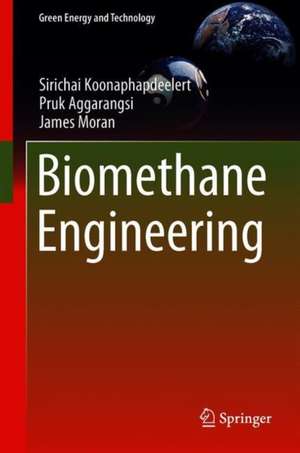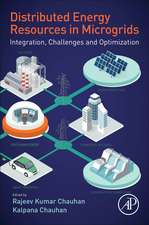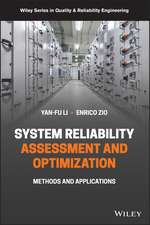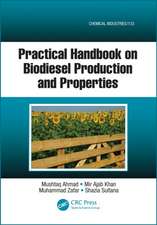Biomethane: Production and Applications: Green Energy and Technology
Autor Sirichai Koonaphapdeelert, Pruk Aggarangsi, James Moranen Limba Engleză Hardback – 18 noi 2019
This book discusses biomethane and the processes and applications downstream from biogas production. Biogas is a result of anaerobic digestion of agricultural or general household waste, such as manure, plants or food waste, and as such is considered a renewable energy source. Biomethane is a gas that results from any process that improves the quality of biogas by reducing the levels of carbon dioxide, hydrogen sulfide, moisture and other contaminant gases. Chemically, biomethane is the same as methane, and its name refers to the method of production rather than the content.
Biomethane plants are generally found in locations with a low population density that are close to farms or food processing plants. In situations where there is no natural gas pipeline nearby, biomethane downstream applications can include storage, transportation, home heating, industrial use and distribution through small-scale local gas grids. This book discusses each of these applications and lists some of the design criteria as well as various issues relating to them.
Biomethane plants are generally found in locations with a low population density that are close to farms or food processing plants. In situations where there is no natural gas pipeline nearby, biomethane downstream applications can include storage, transportation, home heating, industrial use and distribution through small-scale local gas grids. This book discusses each of these applications and lists some of the design criteria as well as various issues relating to them.
| Toate formatele și edițiile | Preț | Express |
|---|---|---|
| Paperback (1) | 579.99 lei 6-8 săpt. | |
| Springer Nature Singapore – 18 noi 2020 | 579.99 lei 6-8 săpt. | |
| Hardback (1) | 728.91 lei 6-8 săpt. | |
| Springer Nature Singapore – 18 noi 2019 | 728.91 lei 6-8 săpt. |
Din seria Green Energy and Technology
- 18%
 Preț: 1691.57 lei
Preț: 1691.57 lei - 20%
 Preț: 566.29 lei
Preț: 566.29 lei - 15%
 Preț: 648.24 lei
Preț: 648.24 lei - 18%
 Preț: 783.20 lei
Preț: 783.20 lei - 18%
 Preț: 961.41 lei
Preț: 961.41 lei - 18%
 Preț: 1115.46 lei
Preț: 1115.46 lei - 18%
 Preț: 944.19 lei
Preț: 944.19 lei - 18%
 Preț: 789.52 lei
Preț: 789.52 lei - 15%
 Preț: 579.81 lei
Preț: 579.81 lei - 15%
 Preț: 645.79 lei
Preț: 645.79 lei -
 Preț: 287.90 lei
Preț: 287.90 lei - 18%
 Preț: 904.60 lei
Preț: 904.60 lei - 18%
 Preț: 903.93 lei
Preț: 903.93 lei - 17%
 Preț: 490.22 lei
Preț: 490.22 lei - 18%
 Preț: 947.35 lei
Preț: 947.35 lei - 15%
 Preț: 592.61 lei
Preț: 592.61 lei - 18%
 Preț: 949.73 lei
Preț: 949.73 lei - 18%
 Preț: 1252.44 lei
Preț: 1252.44 lei - 18%
 Preț: 943.43 lei
Preț: 943.43 lei - 18%
 Preț: 1114.24 lei
Preț: 1114.24 lei - 15%
 Preț: 655.92 lei
Preț: 655.92 lei - 15%
 Preț: 643.34 lei
Preț: 643.34 lei - 24%
 Preț: 590.58 lei
Preț: 590.58 lei -
 Preț: 379.39 lei
Preț: 379.39 lei - 24%
 Preț: 634.04 lei
Preț: 634.04 lei - 17%
 Preț: 464.55 lei
Preț: 464.55 lei - 18%
 Preț: 890.54 lei
Preț: 890.54 lei - 18%
 Preț: 1112.48 lei
Preț: 1112.48 lei - 18%
 Preț: 1394.84 lei
Preț: 1394.84 lei - 18%
 Preț: 1117.03 lei
Preț: 1117.03 lei - 18%
 Preț: 957.62 lei
Preț: 957.62 lei - 18%
 Preț: 1123.15 lei
Preț: 1123.15 lei - 18%
 Preț: 952.09 lei
Preț: 952.09 lei - 18%
 Preț: 891.33 lei
Preț: 891.33 lei - 18%
 Preț: 892.11 lei
Preț: 892.11 lei - 18%
 Preț: 997.09 lei
Preț: 997.09 lei - 18%
 Preț: 789.52 lei
Preț: 789.52 lei - 18%
 Preț: 1124.92 lei
Preț: 1124.92 lei - 18%
 Preț: 1113.71 lei
Preț: 1113.71 lei - 20%
 Preț: 629.52 lei
Preț: 629.52 lei - 24%
 Preț: 1322.07 lei
Preț: 1322.07 lei - 24%
 Preț: 907.48 lei
Preț: 907.48 lei - 18%
 Preț: 952.89 lei
Preț: 952.89 lei - 18%
 Preț: 952.89 lei
Preț: 952.89 lei - 18%
 Preț: 950.52 lei
Preț: 950.52 lei - 18%
 Preț: 940.57 lei
Preț: 940.57 lei
Preț: 728.91 lei
Preț vechi: 888.91 lei
-18% Nou
Puncte Express: 1093
Preț estimativ în valută:
139.51€ • 145.10$ • 116.91£
139.51€ • 145.10$ • 116.91£
Carte tipărită la comandă
Livrare economică 13-27 martie
Preluare comenzi: 021 569.72.76
Specificații
ISBN-13: 9789811383069
ISBN-10: 9811383065
Pagini: 243
Ilustrații: XXXI, 183 p. 108 illus., 104 illus. in color.
Dimensiuni: 155 x 235 mm
Greutate: 0.48 kg
Ediția:1st ed. 2020
Editura: Springer Nature Singapore
Colecția Springer
Seria Green Energy and Technology
Locul publicării:Singapore, Singapore
ISBN-10: 9811383065
Pagini: 243
Ilustrații: XXXI, 183 p. 108 illus., 104 illus. in color.
Dimensiuni: 155 x 235 mm
Greutate: 0.48 kg
Ediția:1st ed. 2020
Editura: Springer Nature Singapore
Colecția Springer
Seria Green Energy and Technology
Locul publicării:Singapore, Singapore
Cuprins
Introduction to Biomethane.- Cleaning Processes.- Upgrading to Biomethane.- Biomethane in Transportation.- Substitution of Biomethane in Domestic and Industrial Applications.- Biomethane in Local Gas Grids.- Future usage for Biogas and Biomethane.
Notă biografică
All three authors are Assistant Professors at Chiang Mai University, two in the Mechanical Engineering Department and one in the Environmental Engineering Department. All authors are also associated with the Energy Research and Development Institute (ERDI) which is a research institute that is affiliated with the Mechanical Engineering department at Chiang Mai University. It is the primary biogas research facility in Thailand.
Textul de pe ultima copertă
This book discusses biomethane and the processes and applications downstream from biogas production. Biogas is a result of anaerobic digestion of agricultural or general household waste, such as manure, plants or food waste, and as such is considered a renewable energy source. Biomethane is a gas that results from any process that improves the quality of biogas by reducing the levels of carbon dioxide, hydrogen sulfide, moisture and other contaminant gases. Chemically, biomethane is the same as methane, and its name refers to the method of production rather than the content.
Biomethane plants are generally found in locations with a low population density that are close to farms or food processing plants. In situations where there is no natural gas pipeline nearby, biomethane downstream applications can include storage, transportation, home heating, industrial use and distribution through small-scale local gas grids. This book discusses each of these applications andlists some of the design criteria as well as various issues relating to them.
Biomethane plants are generally found in locations with a low population density that are close to farms or food processing plants. In situations where there is no natural gas pipeline nearby, biomethane downstream applications can include storage, transportation, home heating, industrial use and distribution through small-scale local gas grids. This book discusses each of these applications andlists some of the design criteria as well as various issues relating to them.
Caracteristici
Explains the engineering behind biomethane, from gas cleaning processes to the upgrading of clean biogas to biomethane Addresses a range of technologies, including water scrubbing and membrane separation Highlights essential engineering aspects, particularly in connection with tropical climates



















